The environmental impact

The impact which the First World War had on the environment only began to be studied a few years ago. But as current research keeps on highlighting, its consequences extend beyond the devastated areas, and will go on being felt for years to come. This article proposes to chart the long history of consciousness of the ecological consequences of the First World War.
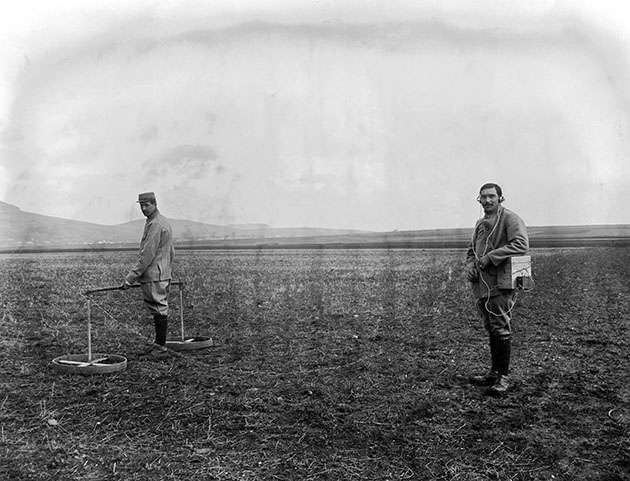
French army mine detector, after the First World War. © Roger-Viollet
Following the Armistice, the only concern for the environmental impact of the war was in terms of restoring the land for human activities, in particular farming. In the collective imagination, when First World War contamination is mentioned, the Épinal print of mine clearance is still the dominant image today. Over the four years of the ‘Great War’, approximately one billion munitions of all types were fired along a front line 700 km long and just a few kilometres wide. Twenty to thirty percent of those projectiles were duds. Some unexploded devices near the surface were cleared during the conflict or soon afterwards. But a large number became buried in the ground, at varying depths, sometimes as much as ten metres. These remnants of war, revealed by the combined effects of different types of erosion, continue to cause accidents, some of them fatal. Added to this mass of unexploded ordnance are more than 1.7 million tonnes of unused or unrecovered surplus munitions which, according to environmental geologist Daniel Hubé, constitute a veritable “chemical reservoir”, about which we have only recently become aware. 4.5% of these shells may contain toxic substances like phosgene, arsenic or yperite. It is difficult today to assess the impact that this ‘time bomb’ could one day have on groundwater, through the corrosion of metal munitions casings ranging from 1 to 6 cm, but it is nevertheless interesting to chart the different events which have contributed to bringing it to our attention.
THE EMERGENCE OF AN ENVIRONMENTAL PROBLEM
In the 1970s, in Belgium, the chance rediscovery, during dredging, of the Paardenmarkt munitions dump just a few hundred metres offshore, prompted the government to launch scientific and historical research. The issue of the burdensome legacy of these three million shells (one-third of which are toxic), dumped at sea in 1919, has yet to be resolved: the authorities have opted for regular monitoring of the dump to assess the impact of its slow deterioration, and to take action only in the event of an emergency, because to decommission it today would be complicated, expensive and dangerous.
This case brought to light how environmental problems have been caused not only by the conflict itself, but by the decisions taken after it. This has also been shown more recently, in France, by two types of resurgence.
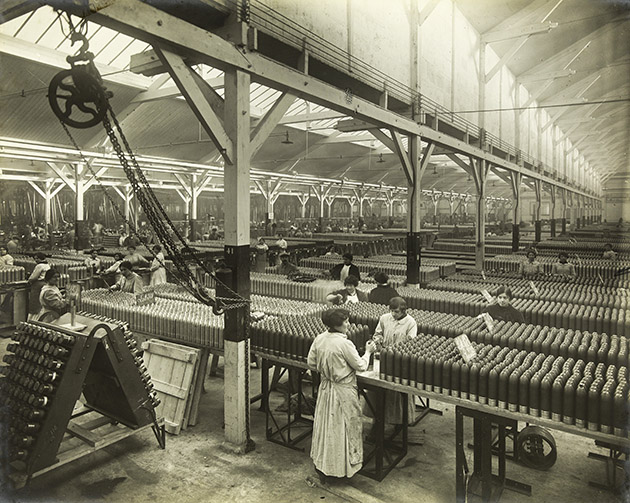
Shell-manufacturing in a Citroën factory, Paris, 7 October 1915. © Musée Carnavalet / Roger-Viollet
In 2011, the Regional Health Authorities (ARS) began to be concerned about the presence of perchlorates in the water supply in the northeastern quarter of France. Noting that the areas where this substance exceeded the recommended values for drinking water (15 micrograms per litre) coincided with the line of the Western Front in the First World War, in 2012 the ARS issued the hypothesis that this pollution was caused by the presence of munitions from that conflict. Asked as part of his role at the Office for Geological and Mining Research (BRGM) to look into this textbook case, environmental engineer Daniel Hubé clarified the sources of the pollution: “During the conflict, French munitions manufacturers produced saltpetre as part of the composition of black powder made from Chilean nitrate, a substance containing natural impurities that include, on average, 1% to 5% potassium perchlorate.” Chilean nitrate, which had been imported by France since the second half of the 19th century for soil enrichment, was also used on a massive scale by farmers from 1919 onwards, when the battlefields were restored to crop-growing.
Even before there was any mention of perchlorates, much was already being written about a well-known sign of First World War contamination in the department of the Meuse. In 2007, German scientists Tobias Bausinger and Johannes Preuss revealed the existence of an area of the Spincourt forest, in the Meuse, which was contaminated with arsenic following the burning of 200 000 chemical shells between the wars. On this site, known as the Place à Gaz, the soil contains large quantities of arsenic derivatives, as well as high levels of cadmium, lead, mercury and other heavy metals. In 2012, the prefecture of the Meuse ordered the site to be sealed off and mandated the BRGM to carry out new investigations on and around the site. These led to the discovery of three other contaminated sites, together constituting a gigantic shell disposal complex where no less than 1.5 million chemical shells and 300 000 explosive shells were disposed from 1919 onwards.
“THESE SITES WERE FORGOTTEN”
What followed was the story of a short-lived industry: one of the first ever industrial recycling operations. In the wake of the First World War, the reconstruction effort required metals, the State was on its knees and the troops had been demobilised, yet there was a need to manage the vast stocks of munitions which, as they deteriorated, became unstable and hazardous. To begin with, they were dumped at sea or blasted.
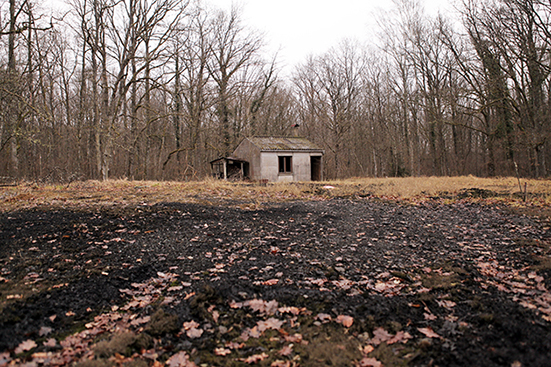
The Place à Gaz, Meuse. © I. Masson-Loodts
But these solutions were not without risk and, above all, represented in the eyes of the State an enormous waste of resources. Private entrepreneurs then seized the opportunity to propose to the government that they would take care of the destruction of this arsenal and the recovery of the scrap metal, in exchange for the payment of an agreed figure per tonne of metal. At least 11 companies were involved in this market.
Around Muzeray, Vaudoncourt and Loison, the hollows and other traces left in the landscape by the industrial activities of Clere & Schwander, still visible in aerial photos from 1987, could not be ignored until reparcelling transformed the land into agricultural plots. How was the history of this land forgotten to the point where it was decided that it should be restored to farmland?
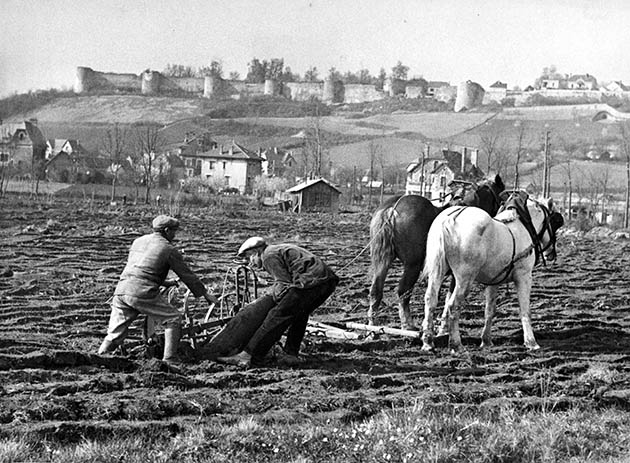
Before the old town walls of Coucy-le-Château, a farmer’s plough hits a large-calibre (350 mm) shell.
© The New York Times / Wide World Photos / Actualit / CEGESOMA collection
According to Daniel Hubé, the societal disorder in the years following the Armistice explains how “in the absence of adequate regulatory tools, these activities could not be properly catalogued and described in administrative documents.” (Sur les traces d’un secret enfoui, Éditions Michalon, 2016.) Indeed, as most of these companies ceased their activities overnight, probably due to the financial crisis at the end of the 1920s, very few of them rehabilitated the land, “but on the ground, the people became so accustomed to the remains that they no longer saw them, which explains how, as time went by, these sites were forgotten.”
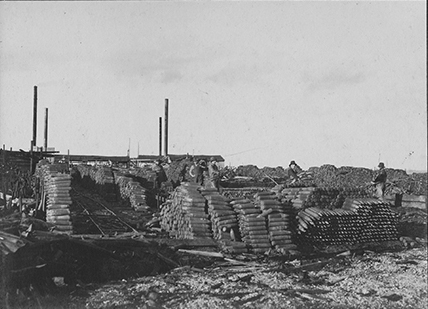
“Spincourt site (Meuse). Toxic German shells being unloaded. Stock of emptied shells to be scrapped.”
Plate from the Clere & Schwander album, 1920s. © Collection E. Hannotin
A REGION-WIDE PROBLEM
In the Meuse departmental archives, and those gathered by local historians, however, a number of documents attest to the fact that legislation at the time already laid down relatively strict rules for this kind of facility. Classed as “filthy and dangerous”, the plant was the subject of a full public enquiry. Yet correspondence from the Minister for War to the Prefect of the Meuse shows that the military authorities chose to ignore the negative opinion of local councillors and residents, even though they were acutely aware of the hazards posed by the facility, highlighted also by analyses of grains that had suffered the effects of toxic gases from the plant’s furnaces. The archives also reveal that, under pressure from agricultural lobbies, the army likely cleared the former battlefields of Champagne and Picardy of the irksome munitions in order to restore the land to farmers as quickly as possible, dumping it all on the devastated territory of the Meuse, where land was less valuable. The map of mass munitions disposal sites drawn up by Daniel Hubé nevertheless shows that the Place à Gaz and the Meuse are neither an isolated case nor an isolated department: “The disposal of First World War munitions did not only leave chemical traces in the soil of the front, but also where the surplus munitions had been stored, not far from their production sites. It may concern the whole region, and perhaps even beyond.
Isabelle Masson-Loodts, archaeologist, journalist and film director

